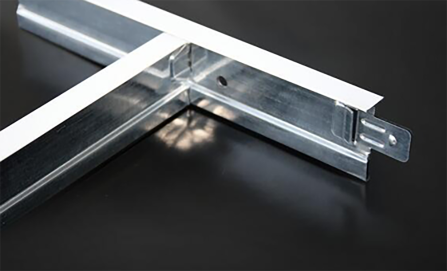- Afrikaans
- Albanian
- Amharic
- Arabic
- Armenian
- Azerbaijani
- Basque
- Belarusian
- Bengali
- Bosnian
- Bulgarian
- Catalan
- Cebuano
- Corsican
- Croatian
- Czech
- Danish
- Dutch
- English
- Esperanto
- Estonian
- French
- German
- Greek
- Hindi
- Indonesian
- irish
- Italian
- Japanese
- Korean
- Lao
- Malay
- Myanmar
- Norwegian
- Norwegian
- Polish
- Portuguese
- Romanian
- Russian
- Serbian
- Spanish
- Swedish
- Thai
- Turkish
- Ukrainian
- Uzbek
- Vietnamese
Pro . 31, 2024 15:38 Back to list
Suspended Ceiling Main Tee Installation and Design Guide for Commercial Spaces
Understanding Suspended Ceiling Main Tee Systems
Suspended ceiling systems, widely used in commercial and residential buildings, play a crucial role in the aesthetics and functionality of a space. One of the key components of these systems is the main tee, a critical element in the structural framework that supports the ceiling tiles and other components.
What is a Suspended Ceiling?
A suspended ceiling, also known as a dropped ceiling or false ceiling, is constructed below the main structural ceiling of a room. This ceiling system is called suspended because it is not directly attached to the existing ceiling but is instead hung from it using a grid of metal supports. This design offers numerous advantages, including improved acoustic performance, easy access to plumbing and electrical systems, and enhanced aesthetics.
The Role of Main Tees
At the heart of a suspended ceiling system is the main tee. Main tees are long, rigid metal strips that run across the ceiling space, providing support for the smaller cross tees and the ceiling tiles themselves. Typically manufactured from galvanized steel, aluminum, or other materials, these main tees are designed to be strong yet lightweight, making them ideal for supporting the ceiling's weight while minimizing strain on the structure above.
Main tees are usually installed in a grid pattern, allowing for maximum flexibility in the design and installation of ceiling tiles of varying sizes and designs. The standard length of a main tee is often 12 feet, and they are typically spaced at 4 feet apart on center, though these dimensions can vary based on specific design requirements and local building codes.
Benefits of Using Main Tees
suspended ceiling main tee

1. Structural Integrity Main tees are engineered to bear significant weight, ensuring that the suspended ceiling can accommodate various tile types and additional fixtures like lighting. This structural integrity is crucial in maintaining ceiling safety and longevity.
2. Flexibility in Design The grid system created by the main tees allows designers and architects to easily create different layouts, incorporating various tiles, lighting options, and ventilation systems as needed. This flexibility can significantly enhance the visual appeal and functionality of a space.
3. Accessibility One of the significant advantages of suspended ceilings, supported by main tees, is the easy access they provide to the infrastructure above, such as ductwork, wiring, and plumbing. In commercial spaces, this ease of access is particularly valuable for maintenance and repairs.
4. Acoustic Control Suspended ceilings help absorb sound, reducing noise levels within a space. The inclusion of acoustic ceiling tiles within the grid of main tees enhances this effect, making noisy environments like offices or schools more conducive to concentration and comfort.
5. Aesthetic Appeal Main tees allow for the creation of a clean, finished look in a room. They can be painted, coated, or integrated with lighting and other decorative elements to complement the overall design theme.
Installation Considerations
Proper installation of main tees is essential for the effectiveness of the suspended ceiling system. Each tee must be securely fastened and leveled to ensure that the grid remains straight and stable. It is also crucial to consider the weight of the ceiling tiles and any additional fixtures when planning the installation.
In conclusion, the main tee is a vital component of a suspended ceiling system. Its strength, flexibility, and supportive role make it indispensable in achieving a functional and aesthetically pleasing environment. Whether in a bustling office, an educational institution, or any other commercial setting, understanding the importance of main tees can help in designing spaces that are both beautiful and practical. As building standards continue to evolve, the role of these components will remain central to the integrity of suspended ceiling systems.
-
Transform Interiors with PVC Gypsum Ceiling: A Stylish, Durable, and Moisture-Resistant SolutionNewsMay.19,2025
-
The Smart Interior Upgrade: Discover the Durability and Versatility of Gypsum Ceiling Access Panel SolutionsNewsMay.19,2025
-
The Smart Choice for Interior Design: Discover the Value of PVC Gypsum Ceiling SolutionsNewsMay.19,2025
-
Mineral Fiber Ceiling Tiles: The Smart Blend of Performance and AestheticsNewsMay.19,2025
-
Mineral Fiber Ceiling Tiles: The Superior Choice Over Gypsum for Sound and Fire SafetyNewsMay.19,2025
-
Mineral Fiber Ceiling Tiles: Eco-Friendly Strength and Style for Every CeilingNewsMay.19,2025







